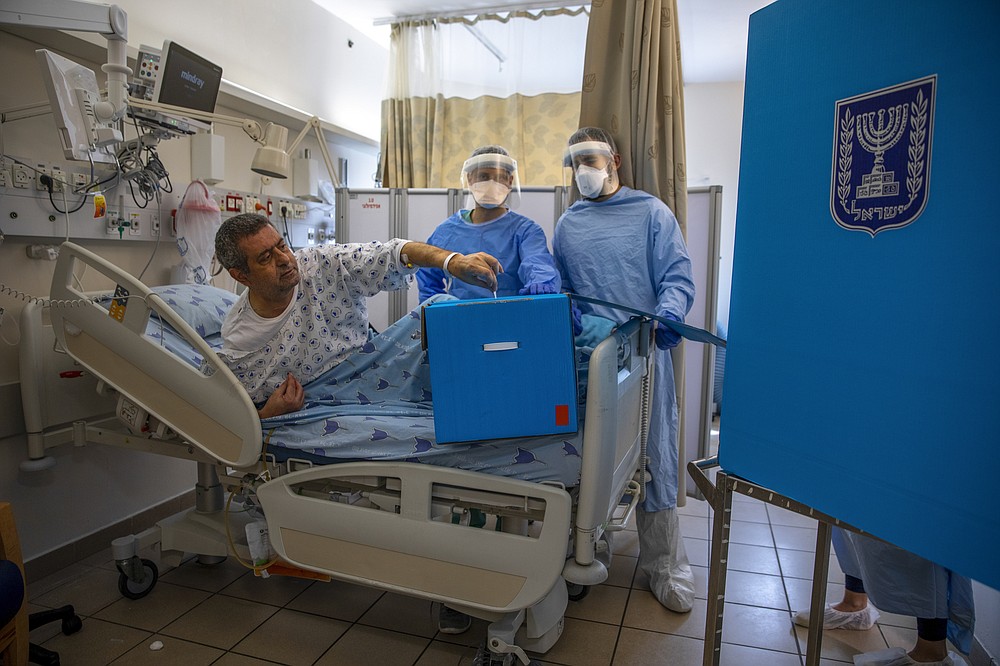Australia/Israel Review
How to vote in a COVID ward
Apr 7, 2021 | Nathan Jeffay

In hospital pyjamas and with oxygen tubes running into his nose, 80-year-old David Nidan shuffled to the ballot box on the morning of Tuesday, March 23.
Eytan, the official managing the polling station, kindly helped the patient to keep his balance. He was wearing a hazmat suit to protect him from the SARS-CoV-2 virus that has kept Nidan in the hospital for the last two weeks.
In an election shaped by the COVID-19 crisis, from campaign talking points to social distancing rules at every polling station, it was the most literal manifestation of politics in a time of pandemic: a polling station in a virus ward.
A regular Israeli polling station caters to 600 people. The one where Nidan voted, at Hillel Yaffe Medical Centre in Hadera, is open for hours to serve just 11 potential voters.
For most of the patients who voted in such stations – around 700 were eligible in total – the journey down the corridor was the farthest they have ventured from bed since hospitalisation.
Some election officials have even gone mobile for the sake of those who can’t move and taken ballot boxes to bedsides.
As patients cast votes at hospitals’ COVID ward stations, home-based virus patients headed to 409 special polling places, while quarantined people have been taking advantage of 342 stations especially designated for them.
From the virus section at Hillel Yaffe, Nidan spoke to the Times of Israel through an intercom that connects his ward to the control room.
He said: “It feels good to be voting,” and revealed that he was backing Likud.
Soon after kippa-wearing Nidan moved away from the ballot box, an Arab woman in a hijab arrived to cast her vote.
In the ward’s control room, the nurses who monitor patients sat alongside election officials: one employee of the Central Elections Committee and two party activists who oversee proceedings, as per Israeli election protocol.
They have a more complex process to check than at regular polling stations. Each voter is given two envelopes. In one, which has no information to identify them, they place a piece of paper that shows their choice of party.
This goes inside an envelope with their identity card number, which is discarded before votes are counted, but is necessary to verify that a ballot hasn’t also been cast in their name at their regular polling station.
When voters arrive, the envelopes are passed through an airlock into the virus ward.
The inspectors, Ofra Mines and Rahamim Michael, sat at a table surrounded by the cookies and snacks that are traditionally provided for those checking polling procedures, along with large bottles of hand sanitiser. When they woke up a few hours earlier and reported for duty, neither of them had any idea they had been assigned to a COVID-19 station.
“I was worried,” said Mines, a 62-year-old Likudnik. “At first I thought I’d actually need to go inside the coronavirus ward, and that concerned me, but it still feels strange sitting here, behind the glass.”
She reported a mix of emotions: joy at seeing people vote and sadness at seeing the harsh reality of a coronavirus ward. “I’m happy to see everyone, including sick people, being given the chance to vote, but it’s hard to see life on the ward,” she said.
One of the nurses, Ahmed Abuhaja, also said he was happy to see patients voting, but reported that there was no election buzz or discussion on the ward. Asked if patients had been talking politics, he said: “Not at all; people here just want to get better and get home.”
Nathan Jeffay is the Times of Israel’s health and science correspondent. © Times of Israel (www.timesofisrael.com), reprinted by permission, all rights reserved.
Tags: coronavirus, Elections, Israel






